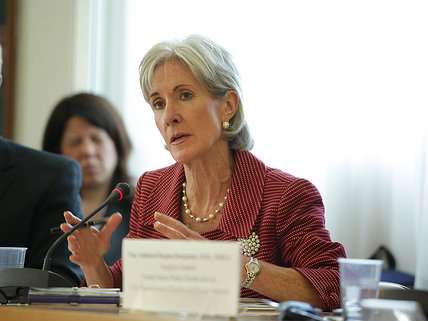ObamaCare Is Working Fine (As Long As No One Tries to Use It)

In an op-ed for USA Today published yesterday evening, Health and Human Services Secretary Kathleen Sebelius touted recent progress the Obamacare tech team has made on repair efforts to the health law's troubled online insurance portal, HealthCare.gov.
"The site is running faster, it's responding quicker and it can handle larger amounts of traffic," Sebelius wrote.
But please, she gently suggested, try to avoid rushing to experience the improvements all at once. Even after saying that "the system is now working smoothly for the vast majority of users," Sebelius also warned that those who prefer to shop online "may want to visit HealthCare.gov in off-peak hours when there is less traffic."
So the online experience is working fine as long as no one* actually uses it?
Some improvements do seem to have been made, but given the near total failure of the initial rollout, that's a pretty low bar. And even still, it seems pretty clear that the new and improved HealthCare.gov still has a few kinks to work out, even on the front-end user experience that was supposed to be significantly improved.
ProPublica's Charles Ornstein chronicled his own test of the reformed website this morning and found "long delays loading pages, an endless circle of tasks (some already completed) and ultimately an error message." His test-run ended with an unhelpful, grammatically incorrect apology, "Sorry theres [sic] a problem with our system," and a recommendation that he log out and try again in 30 minutes. Others, including Reason's Nick Gillespie, are reporting similar glitches in their attempts to use the site.
Maybe these folks are just part of the minority of users still expected to experience trouble. More likely, however, is that the front end of the site still has some significant problems. And remember: That's the portion of the system that the tech repair team prioritized, and was by now supposed to be working smoothly for the vast majority of users.
With 30 to 40 percent of the site, including critical insurer payment systems, yet to be completed and tested, you can bet these problems will continue. Not only because it clearly takes longer than expected to excise flaws from the system, but because lingering problems with the portion that's already been built will take time and energy away from constructing and testing the portions of the system that have yet to be put in place. The administration delayed the Spanish language version of site from its initial planned opening, and just last week announced that the federally run small business exchange that was supposed to open last month would be postponed by a year. The team working on Obamacare is already reported to be working around the clock on repairs; even if they don't burn out from the weeks of long hours, it's inevitable that building additional functionality and putting it through the paces will fall by the wayside if the existing troubles aren't fixed.
Even now, just a day after the relaunch, it seems likely that the performance goals the administration was shooting for have not actually been hit: On a press call this afternoon, a spokesperson for the Centers for Medicare and Medicaid Services backed away from the 50,000 simultaneous users figure that officials provided just yesterday.
If the administration does eventually meet its performance goals, however, it remains to be seen whether they will be enough. In the days following the launch of the exchanges, federal officials falsely claimed that the sole cause of the system's dysfunction was too much traffic. But as we get closer to the deadline for signing up for coverage that begins next year, traffic loads could add to the system's problems. The rebuilt system is supposed to be able to handle about 50,000 concurrent users, but when the site launched, there were as many as 250,000 people trying to log on all at once. If a flood of users does try to sign up in the next few weeks, that could be a problem.
So if demand for enrollment is high, the system is liable to crash again, resulting in more of the kind of frustrations we've already seen. On the other hand, if demand is low, then that suggests a different set of problems—minimal interest in the insurance being sold on the exchanges, and, as a result, smaller risk pools made up of sicker individuals who will be more expensive to insure. Either way, in other words, it won't really work.
*No, I don't literally mean "no one."


Show Comments (52)